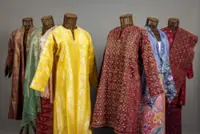The Open Ten choir from Ananda in the Kwa-Zulu Natal region of South Africa performs in a street adjacent to the Natal Playhouse Theatre during a rehearsal ahead of the 2023 edition of the Isicathamiya Festival in Durban, on Sept 23. Photo: AFP
Every little detail counts in an isicathamiya competition: the harmony, the choreography, the costumes, the entrance on stage, the exit and, of course, the singing.
On the recent Saturday night at a Durban theatre in eastern South Africa, Philani Ntuli and his group of 15 singers had just aced their performance, drawing loud cheers from the public.
Already a subscriber? Log in
Save 30% OFF The Star Digital Access
Cancel anytime. Ad-free. Unlimited access with perks.





